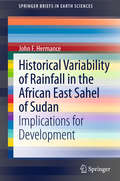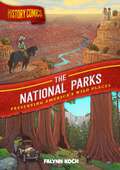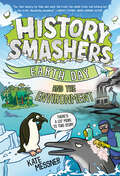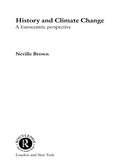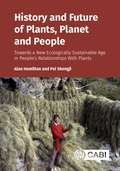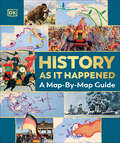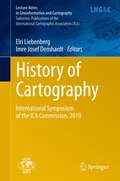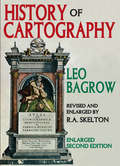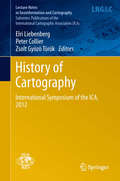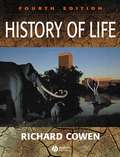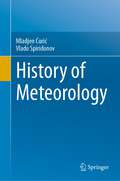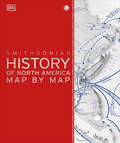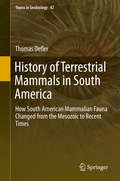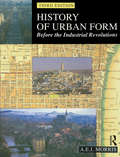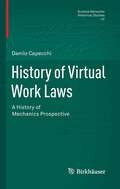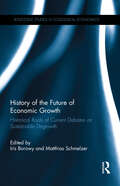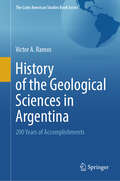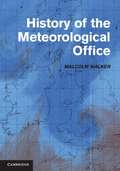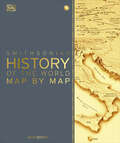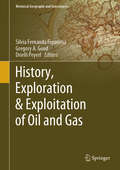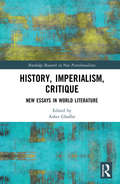- Table View
- List View
Historical Variability of Rainfall in the African East Sahel of Sudan: Implications for Development
by John F. HermanceThe northward migration of the African monsoon rains in summer, associated with the seasonal march of the Intertropical Convergence Zone (ITCZ) across the plains south of the Sahara, is the most critical asset for the livelihoods of indigenous peoples and local economies of the Sahel. It is essential that climate science (and its publicly available database) play a key role in characterizing the variabilities of these rainfall patterns in space and time if sustainable life styles are to accommodate the expanding populations of the region. This study turns to the East Sahel of Sudan by analyzing over 100 years of historical rainfall data from three of the few long term standard WMO rain gauge stations in substantially different rainfall settings. From north to south, transecting the Sahel, the stations with their annual rainfall are Khartoum (130 mm); Kassala (280 mm); and Gedaref (600 mm). The conclusions challenge a popular notion that changing climate, drought and desertification in the East Sahel may have already accelerated the deterioration of its water resources. However, any evidence of a persistent and coherent regional trend of diminishing rainfall is obscure. Quite the contrary, the evidence demonstrates that the fluctuations of climate and weather patterns over the ensuing decades of the past century - at all temporal scales from days to years to decades - profoundly overwhelm any suggestion of a large-scale, coherent decrease (or increase) in rainfall. The implication is that, it is not long term change, but the highly localized interseasonal, interannual and multiannual variability of rainfall that poses the greatest and most immediate societal threat from naturally-induced causes; a process constantly destabilizing an agrarian economy struggling to survive in a climate that irregularly vacillates between years of drought and years of flooding. While this report may have some interest for climate scientists, it is primarily directed to a general readership (including students in public policy and anthropology) concerned with the availability of water in the Sahel, particularly the long term sustainability of local small-scale farms and transhumant pastoralism.
Histories of Bioinvasions in the Mediterranean (Environmental History Ser. #8)
by Simon Pooley Ana Isabel QueirozBioinvasions is a current top research subject for natural sciences, social sciences and humanities and a major concern for conservationists, land managers and planners. In the last decades, new findings, perspectives and practices have revealed the multifaceted challenges of preventing new introductions and dealing with those invasive species that harm natural ecosystems, economy and human welfare. This book brings together environmental historians and natural scientists to share their studies and experiences on the human dimensions of biological invasions from the ancient past to the current challenges. The collection of papers focuses on the Mediterranean region and deals with aquatic and terrestrial ecosystems on the mainland and islands, ranging from marine and freshwater environments to coastal marshlands and forests. A wide diversity of animals and plants are featured, from marine fishes to marine and freshwater crustaceans, invertebrates, reptiles and amphibians, birds and mammals, to grasses, shrubs and trees. This book is a contribution to the scientific debate on how to deal with the historical dimensions of biological invasions, fostering dialogue between cultural and ecological explanations of environmental change, to inform environmental policy and management. It has been organized in three sections: the first is the editors’ introduction, in which they review the existing literature and highlight relevant concepts and ideas; the second is about alien species in the Mediterranean region; the third includes cases from other Mediterranean-type regions.
History Comics: Preserving America's Wild Places (History Comics)
by Falynn KochLet this graphic novel be your time machine—experience history like never before! Our past is only the beginning with History Comics.In this volume, The National Parks: Preserving America's Wild Places, turn back the clock to 1872, when Congress established Yellowstone National Park as an area of unspoiled beauty for the "benefit and enjoyment of the people." Meet the visionaries, artists, and lovers of the American wilderness who fought against corruption and self-interest to carve out and protect these spaces for future generations. See for yourself how the idea of National Parks began, how they've changed, and how they continue to define America.
History Smashers: Earth Day and the Environment (History Smashers)
by Kate MessnerMyths! Lies! Recycling scams? Discover the real story behind the first Earth Day celebration and some of the biggest US climate catastrophes--and their solutions! Don't miss the award-winning History Smashers series as they get to the truth on the biggest environmental fibs!In April 1970, twenty million people grabbed their rakes, gloves, and recycling bins to celebrate the first Earth Day. Since that environmental kickoff, nature has never been in better shape. RIGHT?WRONG! The real deal is a bit muddier than that. It&’s true that the first Earth Day encouraged people around the globe to clean up their act when it came to the environment. But activists have been working for centuries to save the planet! Native people across the world developed sustainable farming practices, women in eighteenth-century India stood up to protect trees, and amateur scientist Eunice Foote discovered the science behind global warming all the way back in the 1850s!Join the History Smashers team to bust history's biggest misconceptions and figure out what in the world really went down before (and after!) the first Earth Day—and how you can join the fight to protect the environment.Ready to bust new myths? Check out more titles in the History Smashers series: The Mayflower • Plagues & Pandemics • The Titanic • The Underground Railroad • The Salem Witch Trials
History and Climate Change: A Eurocentric Perspective (Routledge Studies in Physical Geography and Environment)
by Neville BrownHistory and Climate Change is a balanced and comprehensive overview of the links between climate and man's advance from early to modern times. It draws upon demographic, economic, urban, religious and military perspectives. It is a synthesis of the many historical and scientific theories, which have arisen regarding man's progress through the ages.Central to the book is the question of whether climate variation is a fundamental trigger mechanism from which other historical sequences develop, or one amongst a number of other factors, decisive only when a regime/society is poised for change. Evidence for prolonged climate change is not that extensive. But it is clear that climatic variation has regularly played a part in historical development. Paricular attention is here paid to Europe since AD 211.Cold and warmth, wetness and aridity can create contrary reactions within societies, which can be interpreted in vary different ways by scholars from differenct disciplines. Does climate change exacerbate famine and epidemics? Did climate fluctuation play a part in pivotal historical events such as the mass exodus of Hsuing-nu from China, the pressure of the Huns on the Romans and the genesis of the Crusades? Did the bitter Finnish winter of 1939-40 ensure the ultimate defeat of Hitler? These episodes, and many others are discussed throughout the book in the authors distinctive style, with maps and photographs to illustrate the examples given.
History and Future of Plants, Planet and People: Towards a New Ecologically Sustainable Age in People’s Relationships With Plants
by Professor Alan Hamilton Professor Pei ShengjiThis fascinating book presents the experiences and pooled knowledge of two very different conservation scientists; Pei Shengji from Sichuan, China and Alan Hamilton from London, UK. They have been drawn together over many years through working on some of the same conservation projects and have discovered that they overlap in their ideas about the sorts of work that needs to be done and how it can best be carried out. The book describes some of their own experiences, set within the contexts of their varied careers and the development of their thinking. Plant conservation is crucial to the preservation of natural ecosystems, but conventional approaches have met with only limited success. The authors have concluded that plant conservationists need social allies - elements of society that have other primary concerns, but whose efforts, if successful, will bring benefits to plant conservation too. It is the state and condition of plants on the ground that ultimately matter in conserving ecosystems, and therefore it is the role of local people who interact directly with them which enables success. Ethnobotany is a key skill required of practical plant conservationists. Its techniques enable them to explore connections between people and plants, learn about local perspectives and establish relationships with the people upon whom conservation and sustainable development relies. This book: recommends how to advance plant conservation, based on real experiences. will inspire more people to become involved in plant conservation. demonstrates how the very different backgrounds of the authors have influenced the courses of their careers, but have enabled them to come to very similar conclusions about conservation practice. demonstrates the importance of geographically-based biocultural diversity, as a counterbalancing force to globalisation.
History and GIS: Epistemologies, Considerations and Reflections
by Alexander Von Lünen Charles TravisGeographical Information Systems (GIS) - either as "standard" GIS or custom made Historical GIS (HGIS) - have become quite popular in some historical sub-disciplines, such as Economic and Social History or Historical Geography. "Mainstream" history, however, seems to be rather unaffected by this trend. More generally speaking: Why is it that computer applications in general have failed to make much headway in history departments, despite the first steps being undertaken a good forty years ago? With the "spatial turn" in full swing in the humanities, and many historians dealing with spatial and geographical questions, one would think GIS would be welcomed with open arms. Yet there seems to be no general anticipation by historians of employing GIS as a research tool. As mentioned, HGIS are popular chiefly among Historical Geographers and Social and Economic Historians. The latter disciplines seem to be predestined to use such software through the widespread quantitative methodology these disciplines have employed traditionally. Other historical sub-disciplines, such as Ancient History, are also very open to this emerging technology since the scarcity of written sources in this field can be mitigated by inferences made from an HGIS that has archaeological data stored in it, for example. In most of Modern History, however, the use of GIS is rarely seen. The intellectual benefit that a GIS may bring about seems not be apparent to scholars from this sub-discipline (and others). This book wants to investigate and discuss this controversy. Why does the wider historian community not embrace GIS more readily? While one cannot deny that the methodologies linked with a GIS follow geographical paradigms rather than historical ones, the potential of GIS as a 'killer application' for digital historical scholarship should be obvious. This book brings together authors from Geography and History to discuss the value of GIS for historical research. The focus, however, will not be on the "how", but on the "why" of GIS in history.
History as it Happened
by DKPore over more than 200 maps of the past to understand the world of the present in this children's history book with a difference.Watch the rise and fall of great empires and kingdoms, follow explorers of land and sea on their journeys of discovery, and learn how lucrative trade routes of spices and silk have all changed the way our world looks today.Hundreds of specially commissioned maps guide you through key moments in history, or show how things changed over time. Historical photographs help bring this history to life, while clear, bite-size text allows you to easily follow the story of humankind.History As It Happened breaks down history into simple, manageable chunks. Explore ancient Rome from its beginnings as a small kingdom, through the growth of its power as a republic, to its greatest glory as a continent-spanning empire. With this piece-by-piece approach to investigating history, and with its truly global and inclusive content, this is a children's history atlas like no other!
History of Cartography
by Elri Liebenberg Imre Josef DemhardtThis volume comprises the proceedings of the 2010 International Symposium of the ICA Commission on the History of Cartography. The nineteen papers reflect the research interests of the Commission which span the period from the Enlightenment to the evolution of Geographical Information Science. Apart from studies on general cartography, the volume, which reflects some co-operation with the ICA Commission on Maps and Society and the United States Geological Survey (USGS), contains regional studies on cartographic endeavours in Northern America, Brazil, and Southern Africa.The ICA Commission on Maps and Society participated as its field of study often overlaps with that of the ICA Commission on the History of Cartography. The USGS which is the official USA mapping organisation, was invited to emphasise that the ICA Commission on the History of Cartography is not only interested in historical maps, but also has as mandate the research and document the history of Geographical Information Science. The ICA Commission on Maps and Society participated as its field of study often overlaps with that of the ICA Commission on the History of Cartography. The USGS which is the official USA mapping organisation, was invited to emphasise that the ICA Commission on the History of Cartography is not only interested in historical maps, but also has as mandate the research and document the history of Geographical Information Science.
History of Cartography: Enlarged Second Edition
by Leo BagrowThis illustrated work is intended to acquaint readers with the early maps produced in both Europe and the rest of the world, and to tell us something of their development, their makers and printers, their varieties and characteristics. The authors' chief concern is with the appearance of maps: they exclude any examination of their content, or of scientific methods of mapmaking. This book ends in the second half of the eighteenth century, when craftsmanship was superseded by specialized science and the machine. As a history of the evolution of the early map, it is a stunning work of art and science.This expanded second edition of Bagrow and Skelton's History of Cartography marks the reappearance of this seminal work after a hiatus of nearly a half century. As a reprint project undertaken many years after the book last appeared, finding suitable materials to work from proved to be no easy task. Because of the wealth of monochrome and color plates, the book could only be properly reproduced using the original materials. Ultimately the authors were able to obtain materials from the original printer Scotchprints or contact films made directly from original plates, thus allowing the work to preserve the beauty and clarity of the illustrations.Old maps, collated with other materials, help us to elucidate the course of human history. It was not until the eighteenth century, however, that maps were gradually stripped of their artistic decoration and transformed into plain, specialist sources of information based upon measurement. Maps are objects of historical, artistic, and cultural significance, and thus collecting them seems to need no justification, simply enjoyment.
History of Cartography: International Symposium of the ICA, 2012
by Peter Collier Elri Liebenberg Zsolt Győző TörökThis volume collects 22 papers presented at the 4th International Symposium of the ICA Commission on the History of Cartography, held at Eotvos Lorand University, Budapest, Hungary, on 28-29 June 2012. The overall conference theme is 'Exploration - Discovery - Cartography', but preference has been given to papers dealing with cartography in the 19th and 20th centuries. The papers are classified according to regional sub-themes, i.e. papers on the Americas, papers on Africa, etc.
History of Life
by Richard CowenThis text is aimed at students and anyone interested in the history of life on our planet. It explores the 'whys' of events that occurred, and in this newest edition, it takes a closer look at the evolution of the physical earth and the strong interactions between organisms and environment. The book’s coverage includes geography, climate, atmosphere, ocean, and land (a changing stage) while following interplay between organisms. Also new to this edition is a dedicated website which explores additional environmental factors and supplemental topics, and provides interactive exercises, a detailed glossary, key links and all art in downloadable form. The art is also available to instructors on CD-ROM in PowerPoint and Jpeg formats. An Instructor manual CD-ROM for this title is available. Please contact our Higher Education team at HigherEducation@wiley.com for more information.
History of Meteorology
by Vlado Spiridonov Mladjen ĆurićThis book provides a detailed history of meteorology as a natural science, from an understanding of the Earth's early atmosphere to present-day advancements. In three parts, the book synthesizes developments in quantitative meteorology starting from its very early stages and progressively covers the invention of basic meteorology instruments while highlighting the various turning points and key figures who played roles along the way. The first part addresses the treatment of meteorology during early civilization. Part two goes into the early development of meteorology as a science. Part three covers the science's rapid progression and present-day status while addressing the primary technologies and methodologies used in a variety of areas like weather forecasting, remote sensing, and radar instrumentation. The target audience for the book is students and researchers interested in the history of meteorology as a science, and also general enthusiasts of the subject who have some background on the topic.
History of North America Map by Map (DK History Map by Map)
by DKA visual journey through the history of North America via a series of engaging, detailed maps, explaining key events and eras from prehistory to the 21st century.Specially created maps tell the story of this vast region: the first human populations and the lands of indigenous peoples; the complex ancient civilizations that arose in Mexico; the first Westerners to arrive on the shores, from the Vikings to the Mayflower; early settlements and the devastating consequences for the indigenous population; the stories of enslaved people and the abolition of slavery; the American Revolution and Civil War that shaped the modern United States; the Mexican-American War; the founding of Canada; and the industrial era and the growth of a global superpower. Brand new maps are accompanied by historic maps, documents, and artefacts, while timelines clearly lay out the chronology of events. Each era is introduced and explained, while features offer a closer look at selected moments. Whether for casual browsing or a deep dive into the past, History of North America Map by Map is essential reading for anyone who wants to know more about this fascinating land.
History of Terrestrial Mammals in South America: How South American Mammalian Fauna Changed From The Mesozoic To Recent Times (Topics in Geobiology #42)
by Thomas DeflerThis book takes a non-technical approach in covering the evolution of South American mammalian fauna throughout geological history, and discusses how South America has changed due to mammalian invasions. Unlike other works on the subject, this book attempts to answer several crucial questions that often go unmentioned together in one cohesive monograph. What was the fauna like before the American interchange? What were the origins of the now-extinct groups when northern species arrived and out-competed them? How did the modern mammalian fauna come into being with such disparate animal groups? This information is given from a historical perspective throughout the book's 15 chapters, and is presented in an easily graspable fashion by mostly avoiding technical language. The book is written for academics, scientists and scholars engaged in paleontology, zoology and evolutionary biology, but may also appeal to a larger audience of general readers interested in mammalian evolution. The book begins with an introduction, describing the tools necessary to interpret the evolutionary history of South American mammals in geological terms and some of the early people who helped found South American mammalian paleontology. Chapter 2 describes the Mesozoic first mammals of Gondwana and what we are learning about them, dominant before the K/T extinction event. Then chapters 3 through 8 cover the Cenozoic, or "Age of Mammals", highlighting the major mammalian groups of South America that replaced the earlier mammals of Gondwana. These groups include the marsupials, native ungulates, the xenarthrans (armadillos, anteaters, sloths), the caviomorphs (rodents), and the platyrrhine monkeys. Chapters 9 and 10 address the Antarctic La Meseta fossils and the Colombian La Venta fossil faunal assemblages. Chapter 11 discusses the neotropical mammals that invaded the Caribbean Islands, and illustrates the influence South America has had on adjacent faunas. Chapter 12 describes the origin of the Amazon River and the role it has played in the evolution of the mammals and other flora and fauna. Chapter 13 tells the story of the Great American Biotic Interchange (GABI), and chapter 14 follows this up with a discussion of the Pleistocene mammal communities and their eventual extinction. Chapter 15 concludes the text by discussing the modern mammals of South America, and how despite the extensive Pleistocene extinctions there is still a lot of mammalian diversity in South America.
History of Urban Form Before the Industrial Revolution
by A.E.J. MorrisProvides an international history of urban development, from its origins to the industrial revolution. This well established book maintains the high standard of information found in the previous two editions, describing the physical results of some 5000 years of urban activity. It explains and develops the concept of 'unplanned' cities that grow organically, in contrast with 'planned' cities that were shaped in response to urban form determinants. Spread throughout the texts are copious illustrations from a wealth of sources, including cartographic urban records, aerial and other photographs, original drawings and the author's numerous analytical line drawings.
History of Virtual Work Laws
by Danilo CapecchiThe book presents a history of classical mechanics by focusing on issues of equilibrium. The historical point of view adopted here restricts attention to cases where the effectiveness of forces is assessed on the basis of the virtual motion of their points of application. For completeness, hints of the alternative approach are also referred, the Archimedean for ancient mechanics and the Newtonian for modern mechanics. The laws resulting from consideration of virtual motions are named laws of virtual work. The modern formulations of the principle of virtual work are only a particular form of them. The book begins with the first documented formulations of laws of virtual work in the IV century BC in Greece and proceeds to the end of the XIX century AD in Europe. A significant space is devoted to Arabic and Latin mechanics of Middle Ages. With the Renaissance it began to appear slightly different wordings of the laws, which were often proposed as unique principles of statics. The process reached its apex with Bernoulli and Lagrange in the XVIII century. The book ends with some chapters dealing with the discussions that took place in the French school on the role of the Lagrangian version of the law of virtual work and its applications to continuum mechanics.
History of the Climate Change on the Coromandel Coast: Ninth–Nineteenth Centuries
by S.Jeyaseela StephenThis book offers a deeper historical context to the interplay between the physical fortunes of climate and weather and the ways in which the Tamil society experienced it in the medieval age. It touches upon the rainfall, famines and droughts, storms and cyclones, earthquakes, floods and tsunamis, temperature and atmospheric pressure of the modern age, noticed by the Catholic and Protestant missionaries, European traders, travellers, the East India Company officials and servants using scientific instruments. Based on a greater variety of Tamil sources, missionary letters and reports, British and French colonial records, the monograph presents the reading of history through the lens of climate and provides a more complete picture of Tamil landscape and environment in South India from the ninth to the nineteenth century.
History of the Future of Economic Growth: Historical Roots of Current Debates on Sustainable Degrowth (Routledge Studies in Ecological Economics)
by Matthias Schmelzer Iris BorowyThe future of economic growth is one of the decisive questions of the twenty-first century. Alarmed by declining growth rates in industrialized countries, climate change, and rising socio-economic inequalities, among other challenges, more and more people demand to look for alternatives beyond growth. However, so far these current debates about sustainability, post-growth or degrowth lack a thorough historical perspective. This edited volume brings together original contributions on different aspects of the history of economic growth as a central and near-ubiquitous tenet of developmental strategies. The book addresses the origins and evolution of the growth paradigm from the seventeenth century up to the present day and also looks at sustainable development, sustainable growth, and degrowth as examples of alternative developmental models. By focusing on the mixed legacy of growth, both as a major source of expanded life expectancies and increased comfort, and as a destructive force harming personal livelihoods and threatening entire societies in the future, the editors seek to provide historical depth to the ongoing discussion on suitable principles of present and future global development. History of the Future of Economic Growth is aimed at students and academics in environmental, social, economic and international history, political science, environmental studies, and economics, as well as those interested in ongoing discussions about growth, sustainable development, degrowth, and, more generally, the future.
History of the Geological Sciences in Argentina: 200 Years of Accomplishments (The Latin American Studies Book Series)
by Victor A. RamosThe science of geology is intertwined with the growth of the field in Argentina. This book explores those dual historical developments and, as an expanded translation of Historia de la Geología Argentina: Una Crónica de Más de Dos Siglos, shares them with a global audience. Drawing on the author's extensive work throughout the country as well as documents and photographs from the archives of the National Geological Survey, General Archive of the Nation, and the universities of Buenos Aires, Córdoba, and La Plata, this book offers a once-in-a-century look at developments in the field of geology from a country-specific perspective.
History of the Meteorological Office
by J. M. WalkerMalcolm Walker tells the story of the UK's national meteorological service from its formation in 1854 with a staff of four to its present position as a scientific and technological institution of national and international importance with a staff of nearly two thousand. The Met Office has long been at the forefront of research into atmospheric science and technology and is second to none in providing weather services to the general public and a wide range of customers around the world. The history of the Met Office is therefore largely a history of the development of international weather prediction research in general. In the modern era it is also at the forefront of the modelling of climate change. This volume will be of great interest to meteorologists, atmospheric scientists and historians of science, as well as amateur meteorologists and anyone interested generally in weather prediction.
History of the Meteorological Office
by Malcolm WalkerMalcolm Walker tells the story of the UK's national meteorological service from its formation in 1854 with a staff of four to its present position as a scientific and technological institution of national and international importance with a staff of nearly two thousand. The Met Office has long been at the forefront of research into atmospheric science and technology and is second to none in providing weather services to the general public and a wide range of customers around the world. The history of the Met Office is therefore largely a history of the development of international weather prediction research in general. In the modern era it is also at the forefront of the modelling of climate change. This volume will be of great interest to meteorologists, atmospheric scientists and historians of science, as well as amateur meteorologists and anyone interested generally in weather prediction.
History of the World Map by Map (DK History Map by Map)
by DKExplore the history of the world in unprecedented detail with this ultimate guide to history throughout the ages. Maps don't just show us where to go, but also where we've been. If you're interested in finding out more about the biggest events in world history, then this book all about history of the world is perfect for you!This stunning history book for adults starts with the evolution and migration of our oldest ancestors out of Africa. You can then look up maps about the Greece and Persian War, the Mongol Conquests, Medieval Europe's trade routes, and the rise of the Ottomans. Explore maps about the colonisation of North America, the scientific revolution, Napoleon's advances, and Britain's control of India. Then uncover the history of later centuries, such as the Age of Imperialism, the American Civil War, industrialised Europe and the transformation of Japan.Journey into past like never before as you uncover:- Easy-to-read text panels for a deeper understanding of history- A total of 140 maps alongside stunning pictures and informative timelines- Storytelling maps to bring history to life- Published in association with the Smithsonian Institution in the USA.Bursting with striking illustrations and full of fascinating detail, this history book is the ultimate gift for map lovers, history enthusiasts of all ages and those who enjoy visiting museums and other historical sites, whether as a present for dad, or handy reference guide for any other history lover in your life! History of the World Map by Map aims to help you gain a strong understanding of some of the forces and movements across continents that have shaped our world!Go on guided tour through time and explore:- Prehistory 7 MYA-3000 BCE- The Ancient World 3000 BCE - 500 CE- Middle Ages 500-1450 CE- The Early Modern World 1450-1700- Revolution and Industry 1700-1850- Progress and Empire 1850-1914- The Modern World 1914-PresentAt DK, we believe in the power of discovery.So why stop there? The Map by Map series includes other titles such as History of the World Map by Map and World War II Map by Map, each detailing historical events and placing them in the context of geography. DK's luxurious Map by Map books are fantastic history gifts, packed with fascinating facts, high-quality photography, and detailed profiles and descriptions of people and events.
History, Exploration & Exploitation of Oil and Gas (Historical Geography and Geosciences)
by Silvia Fernanda Figueirôa Gregory A. Good Drielli PeyerlThis edited volume discusses scientific and technological aspects of the history of the oil and gas industry in national and international contexts. <p><p> The search for oil for industrial uses began in the nineteenth century, the first drills made in Azerbaijan and the United States. This intense search for a substance to become one of the most important energy sources was, many times, based on skill as well as luck, resulting in knowledge and the development of prospecting and exploration technologies. <p> The demand for oil improved expertise in geological science, in areas such as micropaleontology, stratigraphy or sedimentology and informed different disciplines such as geophysics. These contributions made possible not only the discovery of new oil fields but also new applications and methods of exploration. Beyond the scientific and technological aspects, an industry that grew to such considerable size also impacted the political, economic, social, cultural, environmental and diplomatic issues in history. The book approaches these changes in different scales, countries, areas, and perspectives. <p> This edited book appeals to researchers, student, practitioners in various fields from geology and geophysics to history. It is also an important resource for professionals in the oil and gas industry.
History, Imperialism, Critique: New Essays in World Literature (Routledge Research in New Postcolonialisms)
by Asher GhaffarThis book examines anti-imperialist thought in European philosophy. It features an international group of both emerging and established scholars who directly respond to Timothy Brennan’s far-reaching call to rethink intellectual histories, literary histories, and the reading habits of postcolonialism, in relation to the anti-imperialist tradition of critique. Each contributor rethinks postcolonial and world literature, Continental thought, and intellectual history in relation to anti-imperialist histories and traditions of critique, through geographically diverse analysis. This book provides a forum for the next generation of scholars to draw on and engage with the marginal yet influential work of the first generation of dissidents within postcolonial studies. It will appeal to researchers and students in the field of postcolonial studies, world literature, geography, and Continental thought.
